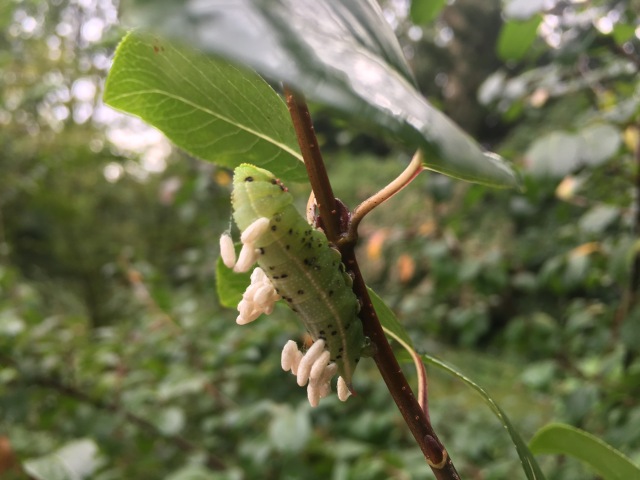
Brachonid wasp cocoons on hornworm caterpillar on Viburnum prunifolium.
A while back we talked about plants you can include in your landscapes to attract predatory insects to your landscapes. This would not only enhance the diversity of your garden but of your insect population and help control insect pests naturally with little input from the gardener.
Another type of beneficial insect you may want to consider attracting to your landscape are the parasitic insects. You may believe that parasitic insects only feed on other insects and so the plant selection doesn’t matter. But, while it is true that the young parasitic insects feed on other insects (from the inside out in many cases!) the adult parasitic insects need nectar and pollen for energy.
Some of the parasitic insects you can expect to find in your landscape (if you look closely enough, some of these are really small) are:
Braconid wasps – these are the producers of the white canons hanging out of the caterpillars, like you see above. The are parasites of beetle, fly and moth larva (grubs, maggots and caterpillars). Remember when you see these guys in action, most likely in the form of tiny cocoons emerging from all angels from a fat caterpillar, leave the caterpillar and cocoons there! They are next year’s crop of beneficial insects!
Ichneumid wasps – also attack grubs, maggots and caterpillars and the pupa associated with each.

Ichneumonid wasp. Note the stinger is adapted for inserting eggs into caterpillars and other soft bodied larval hosts.
Trichogramma wasps – tiny wasps that prey on the eggs of various insects but seem to prefer butterfly and moth eggs.
Tachinid flies – prey on a wide range of landscape and garden pests – these flies are internal parasites of caterpillars, stink bug nymphs, beetle and fly larva as well as true bugs and beetles. You know if you have them working hard in your garden if you inspect an insect and see a tiny white dot on it. Most likely that is a machined fly larva.

Tachinid fly. Photo by Anne Reeves
Scoliid Wasps – plant goldenrod for these in your garden. And if you are a person who is into turf – who who works with clients who are into lawns, you want these in your garden,. These wasps parasitize ground beetle grubs. The dig holes into the soil and find a grub, sting the grub and paralyze it, then lay an egg on the grub and the wasp larva feeds on the paralyzed grub as it matures.

A digger wasp on rigid goldenrod.
Some of the best plants you can plant in your landscape to attract these beneficial insects are plants in the carrot, mint, and aster families. Many plants in these families have what parasitic insects, and other beneficials are looking for – clumps of small flowers close together. You can be sure that if you plant flowers that meet this description, you will have beneficial insects – both predators and parasitoids in your garden.

Many flowers in the composite family will attract beneficials, including parasitic insects to your landscape. In a shady garden try this Blue Wood Aster.
The wonderful thing about this is that you can add these to one place in the landscape and they will benefit the entire landscape – from your tomato plants to the neighbor’s viburnum. The services these insects offer is tremendous. As you plan fall and spring plantings, don’t forget to include some plants for these parasitic friends of the garden.
